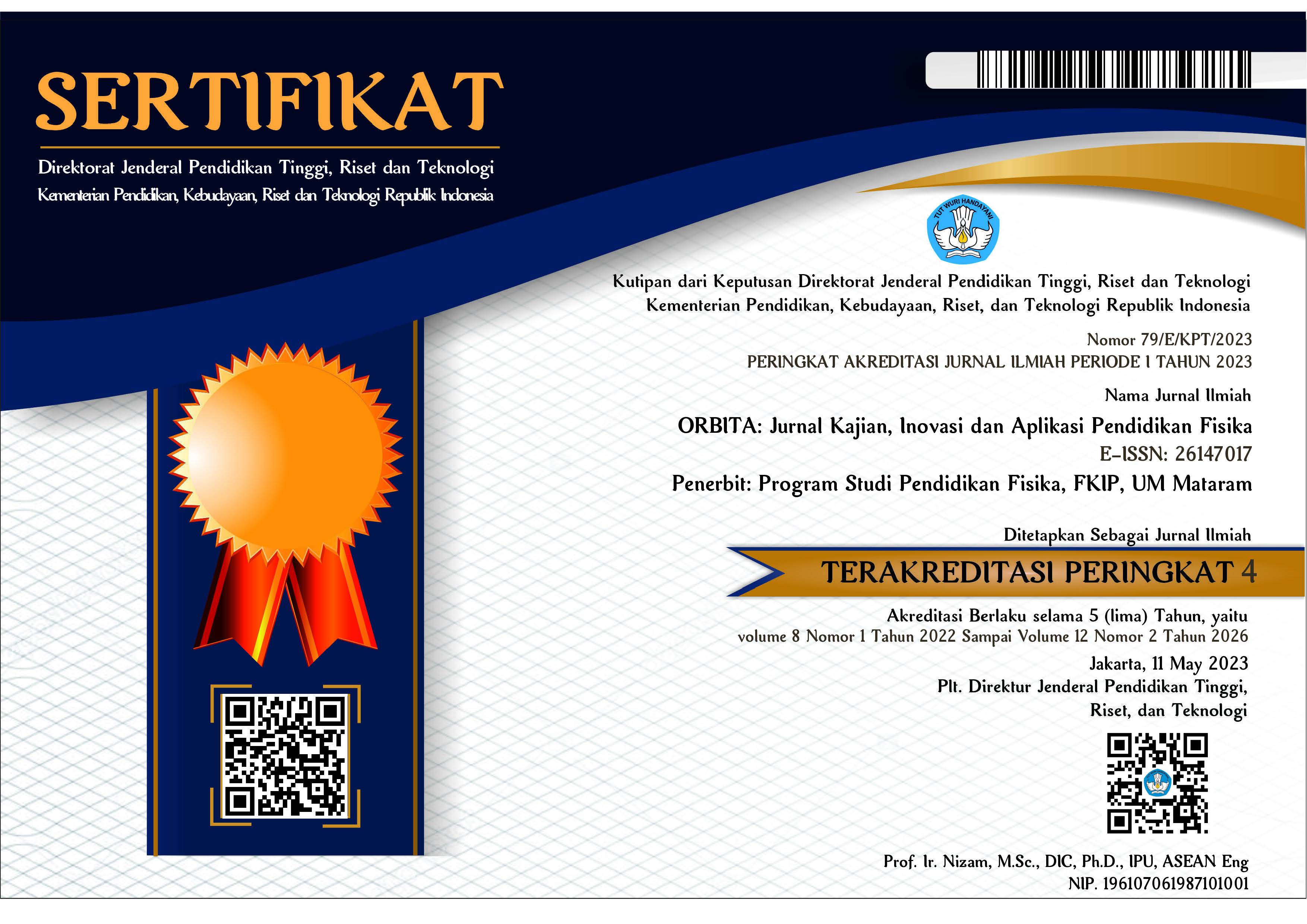PENENTUAN WAKTU MALAM MENGGUNAKAN SKY QUALITY METER DENGAN PENDEKATAN MOVING AVERAGE
Abstract
ABSTRAK
Dalam penelitian ini akan diukur tingkat kecerahan langit untuk mengetahui waktu menghilangnya cahaya merah syafaq yang ada di langit setelah matahari terbenam pada malam hari. Awal waktu malam atau waktu isya diisyaratkan oleh beberapa ulama dengan menghilangnya mega merah atau saat langit benar-benar gelap. Dalam pengukuran tingkat kecerahan langit menggunakan alat Sky Quality Meter (SQM) yang merupakan salah satu teknologi sensor cahaya non image dengan pendekatan pengolahan menggunakan metode Moving Average. Data diperoleh dari SQM yang diambil selama 12 hari berturut-turut pada bulan Maret saat Matahari berada di dekat Ekuator. Hasil penelitian dalam data yang telah diolah dan diproses menunjukkan bahwa awal waktu langit mulai gelap paling awal pada pukul 19:39:19 WIB pada dip matahari 16° 22’ 17” dan paling akhir pada pukul 19:46:12 WIB pada dip 17° 28’ 47”. Dapat disimpulkan dalam penelitian ini cahaya syafaq menghilang berdasarkan pengamatan dan pengolahan menggunakan metode Moving Average menunjukkan pada range 16° 22’ 17” sampai 17° 28’ 47”.
Kata kunci: awal malam; isya; SQM; moving average.
ABSTRACT
In this study, the night sky brightness was measured to determine the disappearance time of the reddish light of syafaq in the sky after sunset. The beginning of the night or Isya is hinted at by some scholars with the disappearance of the red sky or when the sky is completely dark. The measurement of the sky brightness using the Sky Quality Meter (SQM) instrument which is one of the non-image light sensor technologies with the Moving Average approach method. The data were obtained from 12 consecutive days in March when the Sun was near the Equator. The results of this study show that at the beginning of the time the sky begins to darken earliest at 19:39:19 WIB on the solar dip at 16° 22' 17" and the latest at 19:46:12 WIB at dip 17° 28' 47". It can be concluded in this study that the light disappear based on observation and processing using the Moving Average method shows in the range of 16° 22' 17" to 17° 28' 47".
Keywords: night; isya; sqm; moving average.
Keywords
Full Text:
PDFReferences
Abbas, I. (2016). Penerapan Metode Moving Average (MA) Berbasis Algoritma Support Vector Machine (SVM) untuk Membandingkan Pola Kurva dengan Trend Kurva pada Trading Forex Online. ILKOM Jurnal Ilmiah, 8(1), 37–43. https://doi.org/10.33096/ilkom.v8i1.20.37-43
Butar-Butar, A. J. R., Raisal, A. Y., & Pramudya, Y. (2020). Effect of the total lunar eclipse of 28 July 2018 on the night sky brightness at the Observatorium Ilmu Falak Universitas Muhammadiyah Sumatera Utara. Journal of Physics: Conference Series, 1523(1). https://doi.org/10.1088/1742-6596/1523/1/012005
Hassan, A. H., Abdel-Hadi, Y. A., Issa, I. A., & Hassanin, N. Y. (2014). Naked eye observations for morning twilight at different sites in Egypt. NRIAG Journal of Astronomy and Geophysics, 3(1), 23–26. https://doi.org/10.1016/j.nrjag.2014.02.002
Herdiwijaya, D. (2017). WAKTU SUBUH : Tinjauan Pengamatan Astronomi. Jurnal Tarjih, 14(1), 51–64. https://jurnal.tarjih.or.id/index.php/tarjih/article/view/14.104
Pramudya, Y., & Raisal, A. Y. (2017). Aplikasi tingkat kecerlangan langit dalam penentuan waktu subuh. Jurnal Tarjih, 14(1), 65–71. https://jurnal.tarjih.or.id/index.php/tarjih/article/view/14.105
Putraga, H., Rakhmadi, A. J., Firdaus, M. D., & Hidayat, M. (2022). Penentuan Awal Waktu Subuh Menggunakan Kamera DSLR dan Metode Moving Average. 06(02), 114–122. https://doi.org/https://doi.org/10.24198/jiif.v6i2.38995
Qorib, M., Zailani, Z., Radiman, R., & Rakhmadi, A. J. (2019). Peran dan Kontribusi OIF UMSU dalam Pengenalan Ilmu Falak di Sumatera Utara. Jurnal Pendidikan Islam, 10(2), 133–141. https://doi.org/https://doi.org/10.22236/jpi.v10i2.3735
Raisal, A. Y., Pramudya, Y., Okimustava, O., & Muchlas, M. (2019). Pemanfaatan Metode Moving Average dalam Menentukan Awal Waktu Salat Subuh Menggunakan Sky Quality Meter (SQM). Al-Marshad: Jurnal Astronomi Islam Dan Ilmu-Ilmu Berkaitan, 5(1), 1–13. https://doi.org/10.30596/jam.v5i1.3121
Rakhmadi, A. J., Agussani, Gunawan, Akrim, & Yazid raisal, A. (2020). Sky Brightness Measurement for the Construction of the Astronomy Observatory Branch of Universitas Muhammadiyah Sumatera Utara ( OIF UMSU ) in Barus , Central Tapanuli Regency , Indonesia. 6468, 6468–6474.
Rakhmadi, A. J., Setiawan, H. R., & Raisal, A. Y. (2020). Pengukuran Tingkat Polusi Cahaya dan Awal Waktu Subuh di OIF UMSU dengan Menggunakan Sky Quality Meter. Titian Ilmu: Jurnal Ilmiah Multi Sciences, 12(2), 58–65. https://doi.org/10.30599/jti.v12i2.667
Setyanto, H., Prastyo, H. A., Basthoni, M., Fuscha, F. A., & Al, S. M. (2021). ZODIAC LIGHT DETECTION BASED ON SKY QUALITY METER ( SQM ) DATA : PRELIMINARY STUDY. Al-Hilal: Journal of Islamic Astronomy, 3(2), 121–135. https://doi.org/10.21580/al-hilal.2021.3.2.8477
DOI: https://doi.org/10.31764/orbita.v8i2.11363
Refbacks
- There are currently no refbacks.

This work is licensed under a Creative Commons Attribution-ShareAlike 4.0 International License.
______________________________________________________
ORBITA: Jurnal Pendidikan dan Ilmu Fisika
p-ISSN 2460-9587 || e-ISSN 2614-7017
This work is licensed under a Creative Commons Attribution-ShareAlike 4.0 International License.
EDITORIAL OFFICE:



























